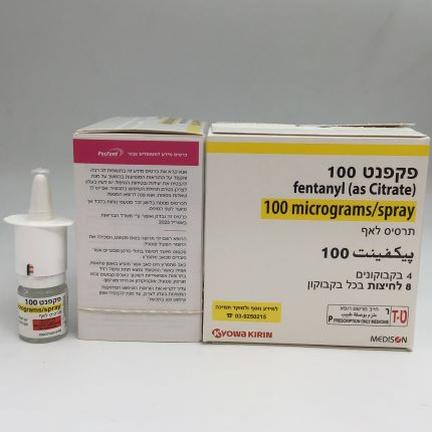Quest for the right Drug

פקפנט 100 PECFENT 100 (FENTANYL AS CITRATE)
תרופה במרשם
תרופה בסל
נרקוטיקה
ציטוטוקסיקה
צורת מתן:
אפי : NASAL
צורת מינון:
ספריי לאף : NASAL SPRAY, SOLUTION
עלון לרופא
מינוניםPosology התוויות
Indications תופעות לוואי
Adverse reactions התוויות נגד
Contraindications אינטראקציות
Interactions מינון יתר
Overdose הריון/הנקה
Pregnancy & Lactation אוכלוסיות מיוחדות
Special populations תכונות פרמקולוגיות
Pharmacological properties מידע רוקחי
Pharmaceutical particulars אזהרת שימוש
Special Warning עלון לרופא
Physicians Leaflet
Adverse reactions : תופעות לוואי
4.8 Undesirable effects Summary of the safety profile Typical opioid adverse reactions are to be expected with PecFent. Frequently, these will cease or decrease in intensity with continued use of the medicinal product, as the patient is titrated to the most appropriate dose. However, the most serious adverse reactions are respiratory depression (potentially leading to apnoea or respiratory arrest), circulatory depression, hypotension and shock and all patients should be monitored for these. The clinical studies of PecFent were designed to evaluate safety and efficacy in treating BTP and all patients were also on background opioid therapies, such as sustained-release morphine or transdermal fentanyl, for their persistent pain. Therefore it is not possible to definitively separate the effects of PecFent alone. Tabulated list of adverse reactions The following adverse reactions have been reported with PecFent and/or other fentanyl-containing compounds during clinical studies and post marketing experience (frequencies defined as very common (≥1/10); common (≥1/100 to <1/10); uncommon (≥1/1,000 to <1/100); rare (≥1/10,000 to <1/1,000); very rare (<1/10,000); unknown (cannot be estimated from available data)). Common Uncommon Unknown Infections and Pneumonia infestations Nasopharyngitis Pharyngitis Rhinitis Blood and lymphatic Neutropenia system disorders Immune system Hypersensitivity disorders Metabolism and Dehydration nutrition disorders Hyperglycaemia Decreased appetite Increased appetite Psychiatric disorders Disorientation Delirium Insomnia Hallucination Drug dependence Confusional state (addiction) Depression Drug abuse Attention deficit/hyperactivity disorder Anxiety Euphoric mood Nervousness Common Uncommon Unknown Nervous system Dysgeusia Loss of consciousness disorders Dizziness Depressed level of Somnolence consciousness Headache Convulsion Ageusia Anosmia Memory impairment Parosmia Speech disorder Sedation Lethargy Tremor Ear and labyrinth Vertigo disorders Cardiac disorders Cyanosis Vascular disorders Cardiovascular Flushing insufficiency Lymphoedema Hypotension Hot flush Respiratory, thoracic Epistaxis Upper airway Respiratory depression and mediastinal Rhinorrhoea obstruction disorders Nasal discomfort Pharyngolaryngeal pain (such as “nasal Rhinalgia burning”) Nasal mucosal disorder Cough Dyspnoea Sneezing Upper respiratory tract congestion Nasal congestion Intranasal hypoaesthesia Throat irritiation Postnasal drip Nasal dryness Gastrointestinal Vomiting Intestinal perforation disorders Nausea Peritonitis Constipation Oral hypoaesthesia Oral paraesthesia Diarrhoea Retching Abdominal pain Tongue disorder Mouth ulceration Dyspepsia Dry mouth Skin and subcutaneous Pruritus Hyperhydrosis tissue disorders Urticaria Musculoskeletal and Arthralgia connective tissue Muscle twitching disorders Renal and urinary Anuria disorders Dysuria Proteinuria Urinary hesitation Common Uncommon Unknown Reproductive system Vaginal haemorrhage and breast disorders General disorders and Non-cardiac chest pain Withdrawal syndrome* administration site Asthenia Neonatal withdrawal conditions Chills syndrome Face oedema Peripheral oedema Gait disturbance Pyrexia Fatigue Malaise Thirst Investigations Platelet count decreased Weight increased Injury, poisoning and Fall procedural Intentional drug misuse complications Medication error *See next section below Description of selected adverse reactions Opioid withdrawal symptoms such as nausea, vomiting, diarrhoea, anxiety, chills, tremor, and sweating have been observed with transmucosal fentanyl. Reporting of suspected adverse reactions Reporting suspected adverse reactions after authorisation of the medicinal product is important. It allows continued monitoring of the benefit/risk balance of the medicinal product. Any suspected adverse events should be reported to the Ministry of Health according to the National Regulation by using an online form Healthcare professionals are asked to report https://sideeffects.health.gov.il/

פרטי מסגרת הכללה בסל
התרופה תינתן לטיפול בכאב מתפרץ בחולי סרטן. התחלת הטיפול בתרופה יעשה על פי מרשם של רופא מומחה באונקולוגיה, או בהמטואונקולוגיה או בכאב או בנוירולוגיה או בהרדמה
שימוש לפי פנקס קופ''ח כללית 1994
לא צוין
תאריך הכללה מקורי בסל
01/03/2008
הגבלות
תרופה מוגבלת לרישום ע'י רופא מומחה או הגבלה אחרת
מידע נוסף
עלון מידע לצרכן
02.08.16 - עלון לצרכן 30.05.22 - עלון לצרכן אנגלית 04.08.22 - עלון לצרכן עברית 30.05.22 - עלון לצרכן ערבית 19.09.22 - עלון לצרכן אנגלית 19.09.22 - עלון לצרכן ערבית 17.01.24 - עלון לצרכן אנגלית 17.01.24 - עלון לצרכן אנגלית 17.01.24 - עלון לצרכן עברית 17.01.24 - עלון לצרכן ערבית 17.01.24 - עלון לצרכן אנגלית 11.02.24 - עלון לצרכן ערבית 14.08.24 - עלון לצרכן אנגלית 14.08.24 - עלון לצרכן עברית 14.08.24 - עלון לצרכן ערבית 19.05.15 - החמרה לעלון 27.11.19 - החמרה לעלון 25.07.21 - החמרה לעלון 04.08.22 - החמרה לעלון 20.11.16 - החמרה לעלון 25.06.19 - החמרה לעלוןלתרופה במאגר משרד הבריאות
פקפנט 100